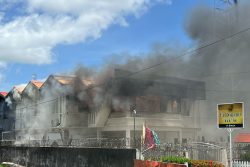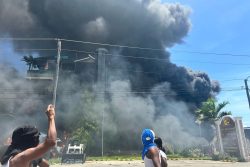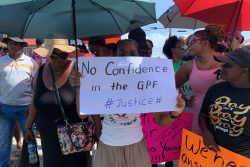The bottom line of our demographic-style politics is that no one comes into office without the support of the Indigenous people. They do not have their own effective political party, and their votes are divided mostly between the two main parties, but nowadays heavily skewed towards the PPP/C. Campaigning in Indigenous areas is therefore critical, but it takes a special form: any government in office goes into the hinterland villages not just with promises for the future, but with concrete handouts. In earlier days outboard engines were one of the favoured items for distribution.
Last week President Irfaan Ali visited communities in Region One, which might have caused some cynical Guyanese to raise a quizzical eyebrow. But on this occasion the benefits on offer were in an entirely different category from the standard outboard engines since they represented potential livelihood improvements, rather than one-off donations. The villagers of Hotoquai, for example, were told that the government intended to develop 250 acres of farmlands there to make the Barima-Waini district a primary food source for the nation.
The President announced the clearing and empoldering of farmlands, and told his audience: “We want to see among these communities present here today, at least 50 acres of land in one central area, dedicated to pineapple [production]. We want to see 100 acres of land dedicated to plantain production.” He went on to assure them that the administration would work with them to ensure that prices for their produce were fair.
In Karaburi, where the residents of six other villages were also present, he announced that Santa Rosa would soon begin large-scale citrus cultivation, and that the Ministry of Agriculture would help in clearing and preparing the land. The plants, said the President, would be brought in. In addition, the Ministry would work with the women of each community to expand honey production and would provide 25 hives per village along with protective gear.
And then the head of state told villagers that the government was moving to promote large-scale coconut cultivation in the Region, along with breadfruit, ginger and spices. “We want to also examine high-value crops that can be grown here. And we are going to support you by putting the investment in preparing the land, giving you the seeds, giving you the planting material so that we can grow and build a huge agriculture sector in this region,” he was quoted as saying. NAREI would return to distribute chemicals to address pest issues.
In Mabaruma, it seems, 500 acres of land will be developed to expand cassava production, and in response to villagers’ queries about the impact of the dry season on crop production, President Ali was reported to have again assured them of immediate support by providing cassava and other planting materials, although unless he was misreported it would hardly be thought that this would have assuaged their doubts.
Last year it was reported the government had invested $25 million in an agro-processing facility for White Water which had increased its cassareep production. And at Waramuri the audience was told that the intention was to establish a coffee plantation, featuring the Arabica and Liberica varieties. DPI made reference to the government’s aim of exploring the possibility of investing in a cargo boat to facilitate the transportation of agricultural products from the region. Of course, all of this came along with the customary highlighting of what the government had achieved in terms of education, health, sports and youth, as well as what more was planned.
No one could fault the government for seeking to improve the livelihoods of Indigenous inhabitants on a long-term basis, but questions arise about how they have gone about it. One cannot avoid the fact that all this agricultural expansion is arriving ready-made at the villagers’ door; there does not seem to have been any prior discussion with them about what they would like to see. Above all it is not the government but the villagers who control their lands under the Amerindian Act, so it is more than a question of the administration descending and asking them to help identify land where they could grow whatever has been decided by Mr Mustapha’s ministry. They have a right to reject whatever proposals about their agricultural development and the use of their land the government puts forward.
Apart from anything else this seems a counter-productive way to proceed, since the communities may well have welcomed most of the measures in any case, and would have been more than disposed to listen since it was the President himself who came. In other words, the government had nothing to lose by laying out its proposals and seeking villagers’ approval. Local inhabitants too, would have been able to supply useful information which might illustrate the need for a modification of this or that project.
The administration’s ingrained habit of trying to evade consultation with Indigenous citizens is illustrated by an advertisement from the National Toshaos Council two weeks ago. It advertised for a consultant to assist it with Free Prior and Informed Consent consultations with the Indigenous communities. Free Prior and Informed Consent is a right recognised in the UN Declaration on the Rights of Indigenous Peoples, and allows them to provide or withhold/withdraw consent in relation to projects which impact their communities.
According to the advertisement the consultant will work, among other things, on the first draft of guidelines for stakeholder engagement with the Indigenous peoples and local communities. Some of the latter have been seriously critical in recent times of both the government and the NTC over the allocation of large areas of land for a carbon credits scheme with the US oil company Hess. The scheme is bringing in a large amount of money, but the Indigenous communities have maintained they were not consulted under Free Prior, etc, principles.
The perception is that the NTC is close to the government, so that its hiring of a consultant constitutes a way to bypass individual Indigenous communities. The government’s and NTC’s problem, however, is that Free Prior Informed Consent applies to the individual villages, not to the Council, so this appointment will not assist the administration in evading the objections of various villages and districts.
As we reported it was the leaders of the Upper Mazaruni District Council and Kako Village who last month registered their dissatisfaction to a carbon credits scheme verifier about the fact the government was not respecting their rights under Free Prior and Informed Consent. In addition, they stated in a release that they had “expressed their hesitancy in conforming to the carbon credits scheme while the Government of Guyana has yet to address key issues such as the land titling programme whereby ancestral lands were excluded from the villages’ land titles.”
They went on to say that their capacity for self-determination and governance was restricted by pressure to submit their Village Sustainability Plans in order to access the carbon credit funds. In general the release relayed a concern about the lack of information in their communities about the Voluntary Carbon Market and called for the authorities to respect their land rights and ensure the full participation of Indigenous peoples in the decision-making process.
For electoral reasons the ruling party wants to keep the Indigenous people onside, and as is its habit it considers the best way of doing that is through control, suppression of criticism and the doling out of benefits. In the old days a simple handout like an outboard engine did not involve any complexities, but times have changed, and carbon credit schemes and the like introduce a new dimension into the Indigenous relationship with coastal politics. The government needs to adopt a far more progressive approach to Indigenous rights.









